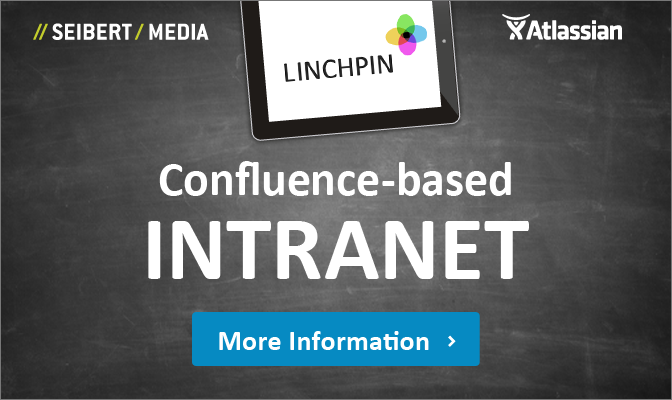Linchpin intranets rock. We have reached a situation where it is increasingly difficult to accept new intranet projects. That is why I have joined a hackathon group, that wants to help customers and us improve workshop efficiency and effectiveness. We are trying to come up with a comprehensive plan, samples, concepts, goals and templates for every project step in a new intranet project.
About Linchpin intranets
In case you didn't know: Linchpin is an intranet solution based on Atlassian Confluence, that enhances the collaboration with a dozen add-ons and comes with a guaranteed fixed price for professional services. Find out more on our Linchpin intranet website.
Share knowledge with customers earlier and faster
The main goal of today's Hackathon project is to get all the experience and knowledge that we have gathered from dozens of intranet projects and hundreds of Confluence projects into this material and hand it over to Linchpin project customers.
We have learned that our customers benefit greatly when they see a customized intranet navigation that another customer has created. That way it is easier for them to prepare and to create a solution faster with less internal discussions.
I hope that we’ll be able to publish this knowledge for free on the web in stages. In the first iteration we’ll share this with existing and new Linchpin customers.
Here is why I am excited about this:
- Improving quality
I am constantly impressed by the ingenuity displayed by our consultants together with our customers. It seems as if each navigation solution is better and more sophisticated than the one before. It’s fueled by consultants sharing their experiences openly. But the more intranet projects we do concurrently, the more complex it is to maintain an overview of what makes a good intranet user profile, and how others have reduced the hassle about profile fields. Having a standard documentation basis helps intranet project teams focus on enhancing specialized aspects and weeding out problems. You can argue, that it decreases the variety of ideas and “out of the box thinking”. But user profile fields for intranet usage have more similarities than differences in huge organizations. - Validating concepts
Most customers join intranet projects with a plethora of concepts and ideas from planning over several months and sometimes even years. They feel they are on the right track when they can validate their own concepts with what we have successfully implemented with other customers. - Reducing costs
One of the big upsides of Linchpin intranets is that we offer a guaranteed fixed price, a reliable budget both for licenses and professional services including all travel expenses and more. When speaking to prospective customers we have found out that the total cost of ownership of Linchpin is a fraction of our competitors' quotes. I have seen Microsoft SharePoint vendors calculate +800% more. It is our task to make sure that customers understand that they do not sacrifice quality when they go for a significantly lower budget. Standardization is the key. - Maintaining a “hands on” approach
Most enterprise projects suck, because teams plan a lot and do very little. Linchpin intranet projects need results to be successful. Our customers do not have time to mull over each tiny aspect of their intranet for months. They want us to help them get experiments out early and have real people test real results early, to learn what works and what doesn't. Having the repetitive stuff documented helps us start quickly and focus on the individual needs of customers more. - Moving faster
One of the big advantages of a Linchpin intranets is the fast delivery. Even in companies with 20,000 employees, we have easily and successfully delivered new intranets in 2 to 6 months. Some of our customers had spent years and multiples of our total budget in the past, and seen no results. This Hackathon project will help us move even faster to the first prototype and deliver results.
Preconfigured Confluence extranet space with all Linchpin templates
As I am writing this, Angela, Florian, Sebastian, Reda, Lukas, Diana, Tobias, Rico and Adil are adding content to a new extranet space. It’s already a tree of pages and documents. The overview includes 33 workshops and project elements throughout the whole process:
Confluence Basic Training, Kickoff Workshop, User profiles, Information Architecture, Content Lifecycle, Design Workshop, Configuration, Theming, Migration of Legacy Systems, Power User Training, Train the Trainer, Admin Training, Test Concept, Go-Live Support, App Management, First Level Support, Bug Fixing, Training documentation & Templates, Plugin Training, Training for Content Editors, Content Migration, Global Dashboard, Space Dashboards, Internal Events (Easy Events), News Concept, Microblog, Navigation structure, App Center, Configuration, Rights Management and Groups, IT Infrastructure, Tracking and Analytics
They are grouped in three phases: Conception, Implementation, Rollout
This is the concept as it stands:
Click here for a download.
As I am not allowed to share any of the templates publicly at this point (working on it), so I’ll stop here and will leave you with the knowledge that this is work in progress. It’s 1:24am and we’ll be on this until 4pm today. 😀
There is no way to get all of this in a perfectly documented state in that time. But some consultants have written a lot already and we only need to bring that into our new Confluence space. #quickwins #awesomestuff
Ping me or pick a slot online to get an updated version of the chart or to talk about this. I am happy to show you these templates in a remote session via screen sharing.
Lesen Sie diese Seite auf Deutsch
Further information
Linchpin: social intranet based on Confluence
A Linchpin Intranet example: DER Touristik
Differentiating between Confluence and Linchpin: Why you need Linchpin for your intranet




